Lonnie Pacelli's Blog, page 37
March 12, 2021
Experiential vs. Inherited Wisdom
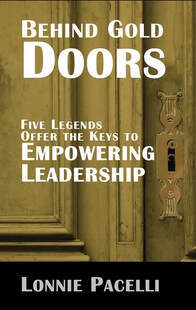 So the older I get the more I think about the lessons I’ve learned in my career. Oh, to go back in time and talk to my younger self about the boneheaded things I did. Sadly, my younger self probably wouldn’t have listened to any imparted wisdom (which I define as knowledge coupled with experience). I was recklessly confident—I didn’t think I would get burned by touching the stove, no matter how many before me got burnt.
So the older I get the more I think about the lessons I’ve learned in my career. Oh, to go back in time and talk to my younger self about the boneheaded things I did. Sadly, my younger self probably wouldn’t have listened to any imparted wisdom (which I define as knowledge coupled with experience). I was recklessly confident—I didn’t think I would get burned by touching the stove, no matter how many before me got burnt.Ah, the naivete of youth.
What I’ve come to realize is that learning hard lessons doesn’t mean I have to experience them first-hand. It’s far less physically, emotionally and financially painful to learn from others. This has led me to an important conclusion--there are two paths to wisdom. The first is experiential wisdom, where I know the stove is hot because I touched it. The second is inherited wisdom, where I believe someone with credibility when they tell me the stove is hot. I could have saved myself a lot of time, stress, and money if I understood and practiced inherited wisdom.
In my zeal to help those still climbing the career mountain, following are my 12 wisdom nuggets to help others avoid experiential wisdom and replace it with inherited wisdom.
Don’t use “ask for forgiveness, not permission” as an excuse for disorganization or laziness – I’m all in for people making urgent decisions without crossing all the Ts, but I’ve also seen many people who were either too lazy or too disorganized to ensure they had appropriate authority to proceed. Both the leader and follower should establish agreed-upon guiding principles for decision making, then make sure any “ask for forgiveness” instances are the exception not the rule.
Throttle actions to urgency – As a younger leader I had difficulty mastering measured responses to situations. I either called in the Cavalry for run-of-the-mill issues or fiddled away while Rome burned. As I got older, I learned to assess a situation and its consequences, then act with the required urgency. When handed an issue, take time to triage it and determine an appropriate course and speed of action.Knowledge is having the answers, wisdom is knowing when to speak up – This is one I’ll be working on until I’m pushing up daisies. Smart people want to have answers and their tendency is to push their point of view on others. But just because you know something doesn’t mean everyone else needs to know how smart you are. Sometimes the best response is no response at all, or a measured response in a different setting.Less answers, more questions – As a young consultant I thought my job was to have all the answers and make sure the client knew I had the answers. Over the years I learned that some of the greatest value I provided to my clients was not answers but the sincere, thought-provoking questions I asked. Respectfully asking questions that challenge the status quo or prevailing points of view were key to defining effective solutions. If you’re not good at asking questions, get some coaching and training. The skill of effectively asking questions will pay dividends throughout your career.Don’t alienate others with your personal points of view – This is particularly important in today’s loose-lipped social media culture. Not everyone shares your point of view on topics like politics, social issues, or religion. Saying things like “unfriend me if you voted for ___” telegraphs how unimportant you consider relationships. Be mindful of what you say and whether you may be inadvertently alienating friends, loved ones, and associates. See this article for more.Realize the importance of recharging the batteries – Chronically burning the midnight oil and depriving yourself of rest and leisure activities simply isn’t sustainable. I learned this lesson the hard way and was forced to take a leave of absence from my job due to physical and emotional exhaustion. Rather than controlling when I took a time-out myself, it was determined for me. Make rest and leisure a priority, not an after-thought.Sacrifice now to protect the future – My first job out of college was the first day I started saving for retirement. It was never a question of whether to save. Through the years I made financial choices to save versus buying things I could live without. I fully understand that some people truly live on a minimalist budget and don’t have the resources to put money away for the future. But for every person in this situation there is another who adopts a “live for today” attitude and chooses buying non-essential items over saving for the future. Make saving a priority if at all possible.Make regret-free family choices – My father died with a lot of regret because he didn’t spend enough time with his kids when they were growing up. He influenced me as a dad to focus on being there for soccer games and school plays. Now that my kids are grown, I can’t imagine the feeling of looking back and saying, “I wish I would have been there for ____.” Don’t make family choices when you’re young that you’ll likely regret when you’re older.Formulate your legacy statement in your working years – I’ve had a number of discussions with people about the right time to think about their legacy statement. I started formulating mine (To help others to help themselves and not simply enable them) in my early forties. It’s been super helpful to have a clear legacy statement as it not only guides me on what I should focus on as well as what I should not focus on. As example, I do a lot of coaching and mentoring with an up-front understanding that it is my job to help the person help him or herself. He or she needs to put at least as much effort in as I do, or we terminate the relationship. Having a clear legacy statement allows me to say yes or no to things depending on how it aligns with that statement.Know the difference between calculated risks and reckless risks – I categorize risk-taking as either calculated (alternatives and consequences are understood before taking an action) or reckless (forging ahead without understanding alternatives and consequences). Look, risk taking is a part of life. The question is whether you’ve thought through the alternatives and consequences and know what is likely to happen under each alternative. Make sure to utilize a coach to help validate your thinking.Run to good opportunities, not away from bad ones – I’ve seen a lot of people make life decisions to leave a bad situation only to go to an even worse situation, then regret it. When you’re evaluating making any life change, consider the pros and cons of each alternative. I have an assessment tool to help you evaluate decisions across nine crucial life elements here.Understand that business ventures can ruin relationships – I lost my best friend at the time due to a bad business deal. We went into it with the best of intentions, but naively didn’t consider the possible impact to our families if things didn’t work out. It affected not only me, but my wife and kids. If you go into business with a friend, be prepared to lose the friend.
Published on March 12, 2021 02:36
March 5, 2021
Free 3/10-11: I'm Too Busy to Plan
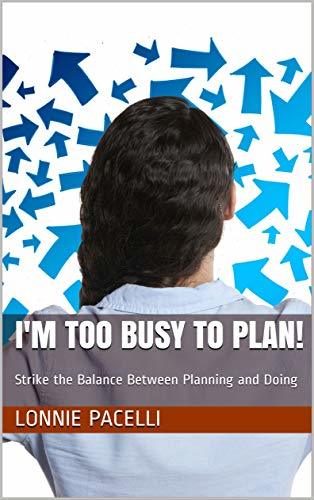 Free 3/10-11: I'm Too Busy to Plan
Free 3/10-11: I'm Too Busy to PlanGet it at https://amzn.to/2Bj6C6k
#freebook #teamwork #leadership #kindle #kindlefire #ebooks #ebook #Kindlefreebooks #Kindledeals #FREE #mustread #goodreads #greatreads #freebie #freebies #kindlebook
Published on March 05, 2021 02:50
Leadership Sniglets
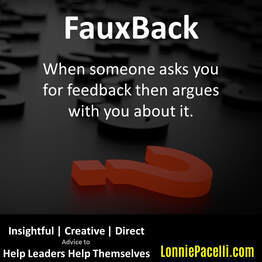 On the 1980s HBO show Not Necessarily the News, comedian Rich Hall created Sniglets, which dictionary.com defines as “any word coined for something that has no specific name. Words like Jokesult (When someone insults you, you call them on it, and they say, "It was just a joke.”) and Chwads (discarded gum found beneath tables and countertops) were born to humorously explain commonplace things or actions. I’ve created 20 of my own project management and leadership sniglets; some made up words, others repurposed words or phrases. I hope they resonate with you and put a bit of humor in your day.ProcrastiCrisis - When a chronic procrastinator creates a last-minute crisis for others to meet a deadline.
On the 1980s HBO show Not Necessarily the News, comedian Rich Hall created Sniglets, which dictionary.com defines as “any word coined for something that has no specific name. Words like Jokesult (When someone insults you, you call them on it, and they say, "It was just a joke.”) and Chwads (discarded gum found beneath tables and countertops) were born to humorously explain commonplace things or actions. I’ve created 20 of my own project management and leadership sniglets; some made up words, others repurposed words or phrases. I hope they resonate with you and put a bit of humor in your day.ProcrastiCrisis - When a chronic procrastinator creates a last-minute crisis for others to meet a deadline.Love Bombing - When nervous execs take up all your time trying to help a project manager on a project in trouble. SME Leakage - When subject matter experts (SMEs) leave a project, and their expertise walks away with them.Go Fetch Delegation - When a manager delegates a small task, the follower executes, then the follower waits for the next task to be delegated. Sleeping Bagger - When someone takes pride in working around the clock during a crisis. Pontifiwaster - The person in a meeting who talks a lot but contributes nothing to the meeting purpose. Surprise Party - When a project manager blindsides his manager with bad news about a project in a public setting.MinMute - On an online meeting or conference call, the quiet time between when someone is asked a question and he says, "Sorry, I was on mute.”MuteCop - The person on an online meeting or conference call who chronically tells others to mute themselves.
Instant LinkPitch - The person who connects with you on LinkedIn and immediately pitches you on his products.Fauxback - When someone asks you for feedback then argues with you about it. FuzzyDater - The project manager who chronically uses “ASAP” or “TBD” when specifying a due date for a task. ZoomPooper - The person who uses the bathroom while his/her camera is still on.ZoomPeeker - The person on an online meeting who looks like he/she is peering over a fence. ZoomMuteLooper - The person on an online meeting or conference call who repeatedly hits the mic button to try and unmute him/herself. ZoomWheezer - The un-muted heavy breather on an online meeting or conference call. FeatureSneaker - The person who tries to get last-minute features added to a solution. ScopeNoper - The project manager who always says “no” to any changes in scope. NonSor - A project sponsor who never shows up. GraveDigger - The project manager who keeps giving bad answers at exec briefings.Have any of your own? Send them on to me!
Published on March 05, 2021 02:50
February 26, 2021
Free 3/3-4: If You Build It They Will Succeed
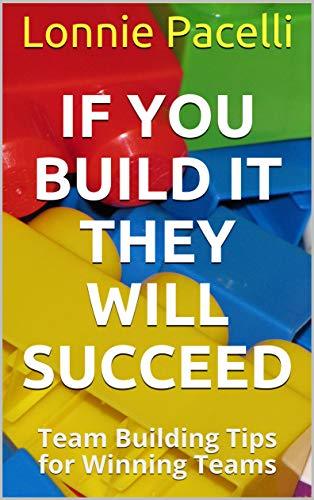 Free 3/3-4: If You Build It They Will Succeed
Free 3/3-4: If You Build It They Will SucceedGet it at https://amzn.to/2Dz8E49
#freebook #teamwork #leadership #kindle #kindlefire #ebooks #ebook #Kindlefreebooks #Kindledeals #FREE #mustread #goodreads #greatreads #freebie #freebies #kindlebook
Published on February 26, 2021 02:50
February 22, 2021
Achievement - Stress = Contentment
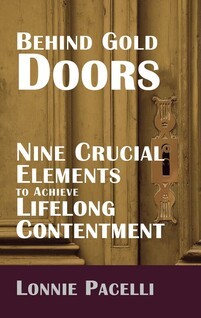 Recently I wrote an article about creating a sustained lifestyle. In the article I introduced a concept which contrasts achievement (doing something meaningful that accomplishes a desired result which gives you joy) and stress (the degree of mental, physical, or emotional strain undertaken to achieve a desired result). In the model I define four different lifestyles driven by achievements and stress, as follows:A frustration lifestyle is the result of high stress accompanied by low achievement. Think burning the midnight oil on projects that get cancelled last-minute or never used.A boredom lifestyle is the result of low stress accompanied by low achievement. Think getting up every morning with nothing to do.A burnout lifestyle is the result of high stress accompanied by high achievement. Think successive strategic projects with demanding customers, a dysfunctional team, and irrational management.A sustained lifestyle is the result of low stress accompanied by high achievement. Think volunteering for a cause you’re passionate about on your work terms.
Recently I wrote an article about creating a sustained lifestyle. In the article I introduced a concept which contrasts achievement (doing something meaningful that accomplishes a desired result which gives you joy) and stress (the degree of mental, physical, or emotional strain undertaken to achieve a desired result). In the model I define four different lifestyles driven by achievements and stress, as follows:A frustration lifestyle is the result of high stress accompanied by low achievement. Think burning the midnight oil on projects that get cancelled last-minute or never used.A boredom lifestyle is the result of low stress accompanied by low achievement. Think getting up every morning with nothing to do.A burnout lifestyle is the result of high stress accompanied by high achievement. Think successive strategic projects with demanding customers, a dysfunctional team, and irrational management.A sustained lifestyle is the result of low stress accompanied by high achievement. Think volunteering for a cause you’re passionate about on your work terms.As I’ve thought more about the achievement/stress concept, it’s occurred to me that the push-pull of achievements and stress apply to more than a person’s career or vocation. It can apply to elements such as family relationships, health, and finances. You can have high achievement/low stress in your career, but if you have low achievement/high stress in another area of your life, your overall contentment level is adversely impacted. It’s not enough to manage achievement and stress only in your career or vocation; it needs to be managed in other areas of your life as well. Given so, I adapted the good-enough contentment model I created for my Behind Gold Doors-Nine Crucial Elements to Achieve Good-Enough Contentment book to include achievement and stress as driving factors. I tested the model on myself (I ate my own dogfood as we like to say at Microsoft) and was surprised at the clarity I found in defining what good-enough contentment means to me. So, here’s the revised model, explained step-by-step:
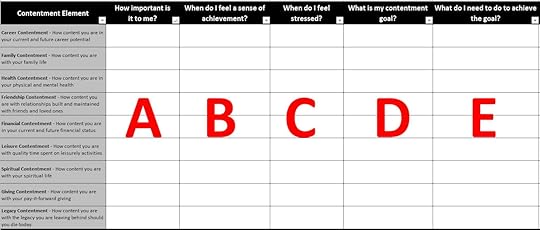 In the good-enough contentment model, there are nine crucial life elements that holistically reflect a person’s life, as follows:Career Contentment - How content you are in your current and future career potentialFamily Contentment - How content you are with your family lifeHealth Contentment - How content you are in your physical and mental healthFriendship Contentment - How content you are with relationships built and maintained with friends and loved onesFinancial Contentment - How content you are in your current and future financial statusLeisure Contentment - How content you are with quality time spent on leisurely activitiesSpiritual Contentment - How content you are with your spiritual lifeGiving Contentment - How content you are with your pay-it-forward givingLegacy Contentment - How content you are with the legacy you are leaving behind should you die todayIn column A, indicate the importance to you for each contentment element:Extremely ImportantVery ImportantSomewhat ImportantNot so importantNot at all importantIn column B, note for each contentment element when you feel a sense of achievement. For example, in the Giving Contentment element you may feel the greatest sense of achievement when you are able to see first-hand when someone’s life situation improves when you’ve given your time or money to help that person.
In the good-enough contentment model, there are nine crucial life elements that holistically reflect a person’s life, as follows:Career Contentment - How content you are in your current and future career potentialFamily Contentment - How content you are with your family lifeHealth Contentment - How content you are in your physical and mental healthFriendship Contentment - How content you are with relationships built and maintained with friends and loved onesFinancial Contentment - How content you are in your current and future financial statusLeisure Contentment - How content you are with quality time spent on leisurely activitiesSpiritual Contentment - How content you are with your spiritual lifeGiving Contentment - How content you are with your pay-it-forward givingLegacy Contentment - How content you are with the legacy you are leaving behind should you die todayIn column A, indicate the importance to you for each contentment element:Extremely ImportantVery ImportantSomewhat ImportantNot so importantNot at all importantIn column B, note for each contentment element when you feel a sense of achievement. For example, in the Giving Contentment element you may feel the greatest sense of achievement when you are able to see first-hand when someone’s life situation improves when you’ve given your time or money to help that person.In column C, note for each contentment element when you feel stressed. For example, in the Health Contentment element you may feel stressed when you weigh yourself and see you’ve gained ten unwanted pounds.In column D, write an honest statement of what your contentment goal is for each element, taking into account how you maximize achievements listed in column B and minimize stress listed in column C.In column E, define specific actions for each element you need to take to get from your current state to your contentment goal in column D. As you work through this model there are a few considerations for you to ponder:Focus on the extremely and very important elements - You can certainly have goals for all the areas, but don’t spend time on an element that is less important at the expense of one more important to you.Be ambitiously realistic - Create goals and actions that are within reach and challenge you, but be careful about putting things down that deep you down know you’ll never achieve.Be brutally honest with yourself – If building a legacy isn’t important to you then say so. The goal isn’t to make every element important, but to consider each element then make the conscious decision whether it is important to you.Recognize that priorities change over time – As you get older, some elements that you felt weren’t important may now be much more so. I’ve certainly found that elements like legacy, giving, friendships, and leisure are more important to me now than when I was in my twenties.
Maximizing achievement and minimizing stress across your life is critical to achieving good-enough contentment. Take some time to download the model and go through the exercise. Comment below with your thoughts!
Published on February 22, 2021 00:00
February 20, 2021
Free 2/24-25: I Suck At This!
 Free 2/24-25: I Suck At This!
Free 2/24-25: I Suck At This!Get it at https://amzn.to/2DRcPZU
#freebook #teamwork #leadership #kindle #kindlefire #ebooks #ebook #Kindlefreebooks #Kindledeals #FREE #mustread #goodreads #greatreads #freebie #freebies #kindlebook
Published on February 20, 2021 02:48
February 18, 2021
Accomplishments - Stress = Contentment
 Recently I wrote an article about creating a sustained lifestyle. In the article I introduced a concept which contrasts achievement (doing something meaningful that accomplishes a desired result which gives you joy) and stress (the degree of mental, physical, or emotional strain undertaken to achieve a desired result). In the model I define four different lifestyles driven by achievements and stress, as follows:A frustration lifestyle is the result of high stress accompanied by low achievement. Think burning the midnight oil on projects that get cancelled last-minute or never used.A boredom lifestyle is the result of low stress accompanied by low achievement. Think getting up every morning with nothing to do.A burnout lifestyle is the result of high stress accompanied by high achievement. Think successive strategic projects with demanding customers, a dysfunctional team, and irrational management.A sustained lifestyle is the result of low stress accompanied by high achievement. Think volunteering for a cause you’re passionate about on your work terms.
Recently I wrote an article about creating a sustained lifestyle. In the article I introduced a concept which contrasts achievement (doing something meaningful that accomplishes a desired result which gives you joy) and stress (the degree of mental, physical, or emotional strain undertaken to achieve a desired result). In the model I define four different lifestyles driven by achievements and stress, as follows:A frustration lifestyle is the result of high stress accompanied by low achievement. Think burning the midnight oil on projects that get cancelled last-minute or never used.A boredom lifestyle is the result of low stress accompanied by low achievement. Think getting up every morning with nothing to do.A burnout lifestyle is the result of high stress accompanied by high achievement. Think successive strategic projects with demanding customers, a dysfunctional team, and irrational management.A sustained lifestyle is the result of low stress accompanied by high achievement. Think volunteering for a cause you’re passionate about on your work terms.As I’ve thought more about the achievement/stress concept, it’s occurred to me that the push-pull of achievements and stress apply to more than a person’s career or vocation. It can apply to elements such as family relationships, health, and finances. You can have high achievement/low stress in your career, but if you have low achievement/high stress in another area of your life, your overall contentment level is adversely impacted. It’s not enough to manage achievement and stress only in your career or vocation; it needs to be managed in other areas of your life as well. Given so, I adapted the good-enough contentment model I created for my Behind Gold Doors-Nine Crucial Elements to Achieve Good-Enough Contentment book to include accomplishment and stress as driving factors. I tested the model on myself (I ate my own dogfood as we like to say at Microsoft) and was surprised at the clarity I found in defining what good-enough contentment means to me. So, here’s the revised model, explained step-by-step:
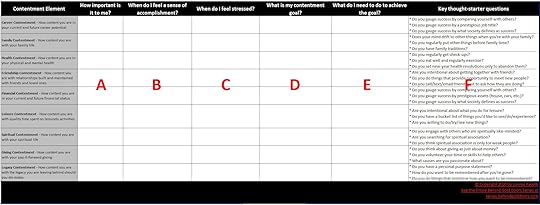 In the good-enough contentment model, there are nine crucial life elements that holistically reflect a person’s life, as follows:Career Contentment - How content you are in your current and future career potentialFamily Contentment - How content you are with your family lifeHealth Contentment - How content you are in your physical and mental healthFriendship Contentment - How content you are with relationships built and maintained with friends and loved onesFinancial Contentment - How content you are in your current and future financial statusLeisure Contentment - How content you are with quality time spent on leisurely activitiesSpiritual Contentment - How content you are with your spiritual lifeGiving Contentment - How content you are with your pay-it-forward givingLegacy Contentment - How content you are with the legacy you are leaving behind should you die todayIn column A, indicate the importance to you for each contentment element:Extremely ImportantVery ImportantSomewhat ImportantNot so importantNot at all importantIn column B, note for each contentment element when you feel a sense of accomplishment. For example, in the Giving Contentment element you may feel the greatest sense of accomplishment when you are able to see first-hand when someone’s life situation improves when you’ve given your time or money to help that person.In column C, note for each contentment element when you feel stressed. For example, in the Health Contentment element you may feel stressed when you weigh yourself and see you’ve gained ten unwanted pounds.In column D, write an honest statement of what your contentment goal is for each element, taking into account how you maximize accomplishments listed in column B and minimize stress listed in column C.In column E, define specific actions for each element you need to take to get from your current state to your contentment goal in column D.
In the good-enough contentment model, there are nine crucial life elements that holistically reflect a person’s life, as follows:Career Contentment - How content you are in your current and future career potentialFamily Contentment - How content you are with your family lifeHealth Contentment - How content you are in your physical and mental healthFriendship Contentment - How content you are with relationships built and maintained with friends and loved onesFinancial Contentment - How content you are in your current and future financial statusLeisure Contentment - How content you are with quality time spent on leisurely activitiesSpiritual Contentment - How content you are with your spiritual lifeGiving Contentment - How content you are with your pay-it-forward givingLegacy Contentment - How content you are with the legacy you are leaving behind should you die todayIn column A, indicate the importance to you for each contentment element:Extremely ImportantVery ImportantSomewhat ImportantNot so importantNot at all importantIn column B, note for each contentment element when you feel a sense of accomplishment. For example, in the Giving Contentment element you may feel the greatest sense of accomplishment when you are able to see first-hand when someone’s life situation improves when you’ve given your time or money to help that person.In column C, note for each contentment element when you feel stressed. For example, in the Health Contentment element you may feel stressed when you weigh yourself and see you’ve gained ten unwanted pounds.In column D, write an honest statement of what your contentment goal is for each element, taking into account how you maximize accomplishments listed in column B and minimize stress listed in column C.In column E, define specific actions for each element you need to take to get from your current state to your contentment goal in column D.As you work through this model there are a few considerations for you to ponder:Focus on the extremely and very important elements - You can certainly have goals for all the areas, but don’t spend time on an element that is less important at the expense of one more important to you.Be ambitiously realistic - Create goals and actions that are within reach and challenge you, but be careful about putting things down that deep you down know you’ll never achieve.Be brutally honest with yourself – If building a legacy isn’t important to you then say so. The goal isn’t to make every element important, but to consider each element then make the conscious decision whether it is important to you.Recognize that priorities change over time – As you get older, some elements that you felt weren’t important may now be much more so. I’ve certainly found that elements like legacy, giving, friendships, and leisure are more important to me now than when I was in my twenties.
Maximizing accomplishments and minimizing stress across your life is critical to achieving good-enough contentment. Take some time to download the model and go through the exercise. Comment below with your thoughts!
Published on February 18, 2021 02:51
February 12, 2021
Free 2/17-18: Humor-Credibility=Doofus
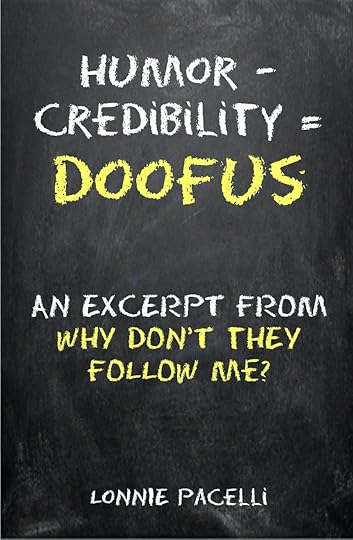 Free 2/17-18: Humor-Credibility=Doofus
Free 2/17-18: Humor-Credibility=DoofusGet it at https://amzn.to/2S3rVOS
#freebook #leadership #kindle #kindlefire #ebooks #ebook #Kindlefreebooks #Kindledeals #FREE #mustread #goodreads #greatreads #freebie #freebies #kindlebook #ad #teamwork
Published on February 12, 2021 02:48
February 11, 2021
Retirement Redefined: Eight Tips to Creating a Sustained Lifestyle
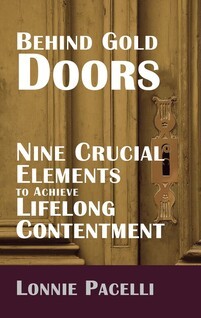 In 2004, I left Microsoft so Patty and I could homeschool our son Trevor. He was diagnosed with Autism Spectrum Disorder at age five, and we decided as he was entering seventh grade that he would need more help than what his public school could offer. I was his math and science teacher for two years until he re-entered public school in ninth grade. After my homeschooling stint, I decided to focus on writing and consulting, and later Patty and I starting a publishing business. From that point until now, I have regularly been asked if I’m “retired.” At first, I would respond with a strong “no” due to my opinion that retirees spend their days on the golf course or playing bridge. Over time, though, I recognized I had to come up with a better description of what I do as a profession. It’s not a choice of either the golf course or the 8-to-5 grind. For me, it’s something I call sustained lifestyle.
In 2004, I left Microsoft so Patty and I could homeschool our son Trevor. He was diagnosed with Autism Spectrum Disorder at age five, and we decided as he was entering seventh grade that he would need more help than what his public school could offer. I was his math and science teacher for two years until he re-entered public school in ninth grade. After my homeschooling stint, I decided to focus on writing and consulting, and later Patty and I starting a publishing business. From that point until now, I have regularly been asked if I’m “retired.” At first, I would respond with a strong “no” due to my opinion that retirees spend their days on the golf course or playing bridge. Over time, though, I recognized I had to come up with a better description of what I do as a profession. It’s not a choice of either the golf course or the 8-to-5 grind. For me, it’s something I call sustained lifestyle.So, what’s sustained lifestyle? Here’s the definition, then we’ll unpack it:Sustained lifestyle is when you have a high sense of achievement accompanied by a low degree of stress, making it something you can sustain for a long time.First let’s talk about achievement. This is about doing something meaningful that accomplishes a desired result which gives you joy. It could be delivering a project on time, helping people in need, or coaching lesser experienced professionals. It’s about getting something done that matters to you and seeing the fruits of your labor.
Next is stress. This is the degree of mental, physical or emotional strain undertaken to achieve a desired result. Delivering a project on time with high-pressure executive meetings, project team infighting, and an unreasonable customer is much more taxing than one with cooperative execs, project team members, and customers. The end result is a completed project, but the execution was like pedaling uphill in tenth gear.
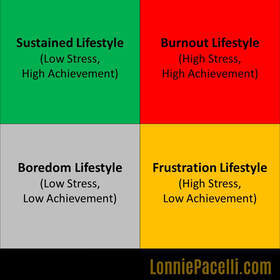 When stress and achievement are combined in the context of lifestyle, one of the four results are realized:
When stress and achievement are combined in the context of lifestyle, one of the four results are realized:A frustration lifestyle is the result of high stress accompanied by low achievement. Think burning the midnight oil on projects that get cancelled last-minute or never used.
A boredom lifestyle is the result of low stress accompanied by low achievement. Think getting up every morning with nothing to do.
A burnout lifestyle is the result of high stress accompanied by high achievement. Think successive strategic projects with demanding customers, a dysfunctional team, and irrational management.
A sustained lifestyle is the result of low stress accompanied by high achievement. Think volunteering for a cause you’re passionate about on your work terms.Now don’t get me wrong; I’m in no way saying that a sustained lifestyle means no stress. There are certainly things in life that crop up and cause great stress. However, a sustained lifestyle gives you margin to handle unexpected stress more effectively than if your stress bucket were already full.
Here are eight tips to create a sustained lifestyle that’s enjoyable and fulfilling for you:
Run to a vocation – Creating a sustained lifestyle entails having a post-career plan that you work to once you’ve left your job. The plan could be to discover your sustained lifestyle vocation or, if you already know what you want to do, how to make that sustained lifestyle a reality. Painting a picture in your head of what it will look like will help you get excited about giving it life.Be clear on your decision criteria – Deciding on what your sustained lifestyle looks like means being very honest with yourself on your decision criteria. Is a continued income important or necessary? Will you need something that continues to feed your ego? Is the flexibility to say no to things important? No right or wrong answers on the criteria, but be deliberate about defining it. This Excel-based assessment tool will help you think about your criteria using nine crucial contentment elements. Make each day purposeful – I have a theme for each weekday that focuses on some aspect of my vocation; Monday is Amazon book ads day; Tuesday is article writing day (Yes, I’m writing this article on a Tuesday.); Wednesday is mentoring day, etc. While I may move things around based on schedules, I know what my core activities will be on each day of the week.Agree on the guiding principles with your spouse/partner – Patty and I have several guiding principles on our sustained lifestyle, the most important being the freedom to do what we want from wherever we want. We enjoy travel and regularly do winter treks to warmer weather. We can continue publishing books and I can write regardless of where we are. Having an understanding between you and your spouse/partner about what is important and what you want to protect is crucial to a happy sustained lifestyle.Have at least one goal you’re working toward – After my father-in-law sold his locksmith business, he took on other hobbies which kept him growing, most notably photography. Having goals not only keeps you learning, but also satisfies the need for a sense of accomplishment.Be accountable – I am a member of a men’s business group that meets twice a month. Three of us want to drop some extra pounds, so we agreed that before each meeting we will share our current weight with each other. It’s amazing how much more I think about what I consume because I don’t want to report poor progress to my colleagues. Having accountability to someone else helps you focus on your goal and work harder to achieve it. Be mindful about what stresses you out – Keeping a wide distance between achievement and stress means being honest with yourself about what stresses you out and putting things in place to keep stress to a minimum. Know your stressors and keep them in check.Create a comfortable space – I have a standup desk in our den with three monitors and a large screen TV on the wall. Every morning, after getting my first cup of coffee, I go to my workstation and use it throughout the day. It’s a very comfortable setup that I enjoy and don’t mind spending time at.
Whether you’re at retirement age, close to it, or merely thinking about it, keep the concept of a sustained lifestyle front and center. Think high achievement and low stress.
Published on February 11, 2021 02:48
February 5, 2021
Free 2/10-11: Six-Word Lessons on Growing Up Autistic (Spanish Translation)
 Free 2/10-11: Six-Word Lessons on Growing Up Autistic (Spanish Translation)
Free 2/10-11: Six-Word Lessons on Growing Up Autistic (Spanish Translation)Get it at https://amzn.to/2OeyBN6
#kindle #kindlefire #ebooks #ebook #Kindlefreebooks #Kindledeals #FREE #mustread #goodreads #greatreads #freebie #freebies #kindlebook #freebook #autism #autistic
Published on February 05, 2021 02:48



